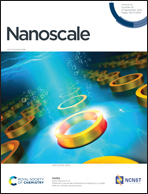Controlled synthesis of solid-shelled non-spherical and faceted microbubbles†
Abstract
The ability to control the shape of hollow particles (e.g., capsules or bubbles) holds great promise for enhancing the encapsulation efficiency and mechanical/optical properties. However, conventional preparation methods suffer from a low yield, difficulty in controlling the shape, and a tedious production process, limiting their widespread application. Here, we present a method for fabricating polyhedral graphene oxide (GO)-shelled microbubbles with sharp edges and vertices, which is based on the microfluidic generation of spherical compound bubbles followed by shell deformation. Sphere-to-polytope deformation is a result of the shell instability due to gradual outward gas transport, which is dictated by Laplace pressure across the shell. The shape-variant behaviours of the bubbles can also be attributed to the compositional heterogeneity of the shells. In particular, the high degree of control of microfluidic systems enables the formation of non-spherical bubbles with various shapes; the structural motifs of the bubbles are easily controlled by varying the size and thickness of the mid-shell in compound bubbles, ranging from tetrahedra to octahedra. The strategy presented in this study provides a new route for fabricating 3D structured solid bubbles, which is particularly advantageous for the development of high-performance mechanical or thermal material applications.



 Please wait while we load your content...
Please wait while we load your content...